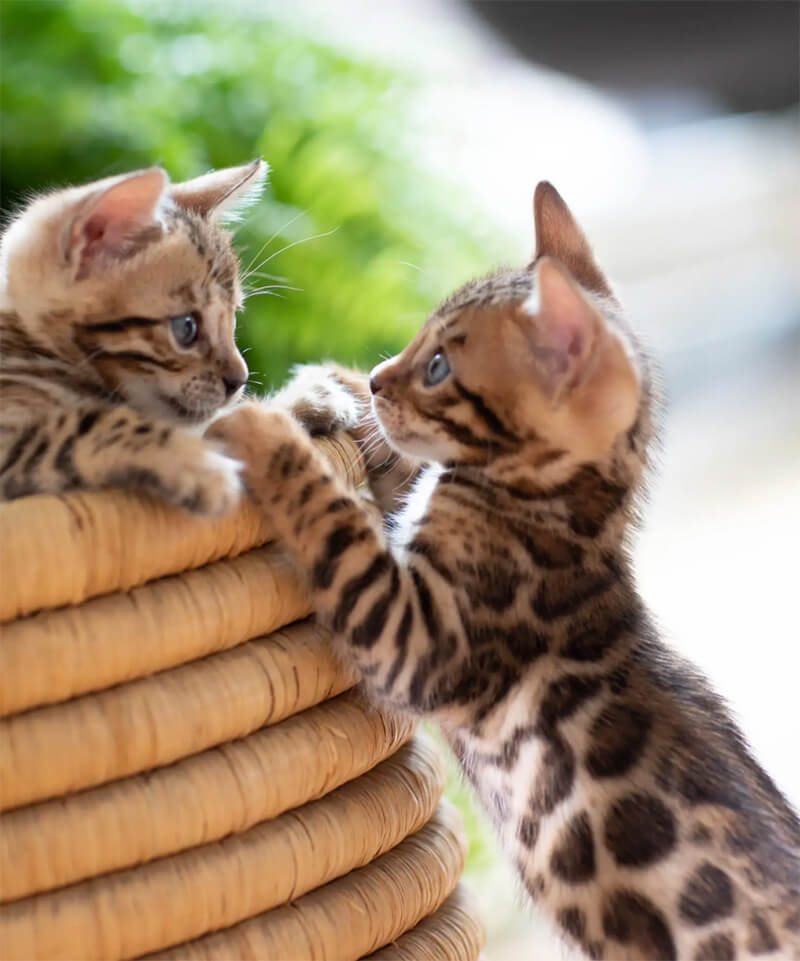Is your cat expecting? – these are exciting times for you both!
But not to worry – Cats intuitively know how to manage and are pretty self-sufficient for the most part. However, you can help the future mum to be as comfortable as possible and help her with the task of delivering healthy kittens into this world. What is the duration of a cat’s pregnancy? What is a perfect birthing box and what will the event itself look like?
Many questions will come to mind when you have not experienced this before.
This is why we have collected all the necessary information here for you on what a pregnant cat needs and what important factors should be considered – a digital birth preparation so to speak!
How do you spot the pregnancy?
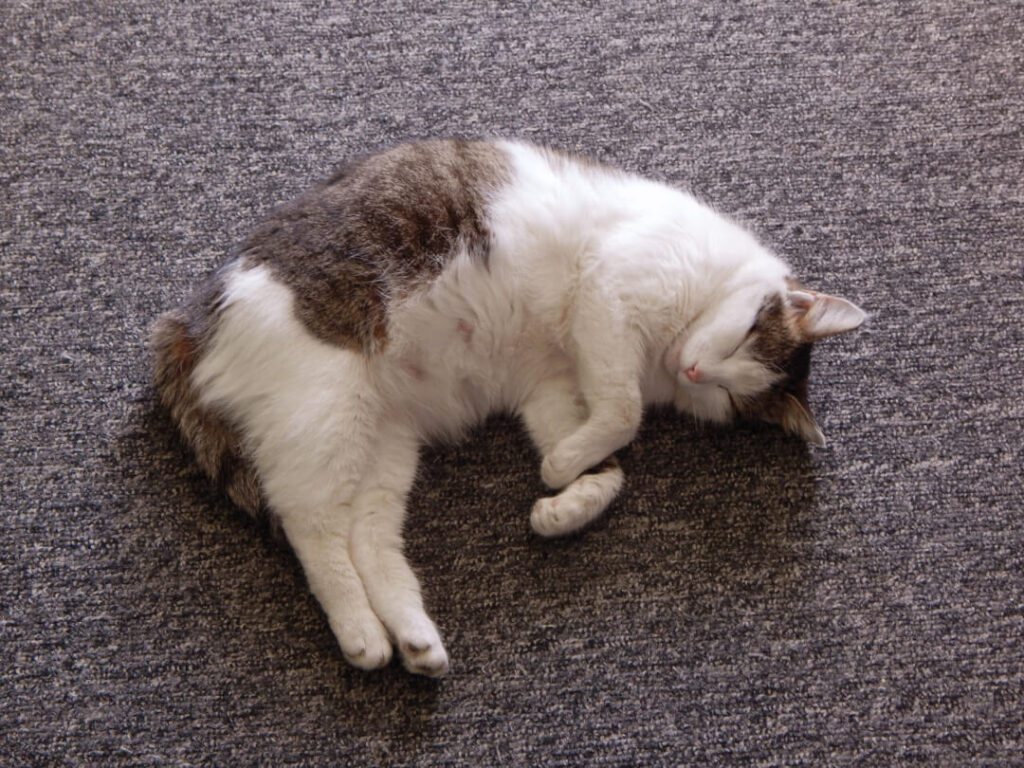
There are certain signs telling you that your animal could be pregnant. Many are slightly similar to the ones we know from human beings.
Cravings for particular foods are an indicator as well as morning sickness and a steadily growing belly. If your cat suddenly has even more cravings than usual and gets bigger around the waist, that still doesn’t necessarily mean that offspring are in sight!
However, if this is accompanied by morning sickness, if the nipples are swollen and your cat is even more affectionate than usual, the accumulating signs could well mean that you can count on additional kittens in your house soon.
When do cats get pregnant?
Cats are extremely fertile animals. A non-neutered cat can deliver up to three times a year! As soon as it is fertile and receptive, it can get pregnant.
The fertile, or “on heat” days are obviously those on which your cat can get pregnant. Receptive and non-neutered, this can be the case every two to three weeks.
At what age are cats sexually mature?
When do cats reach sexual maturity?
Cats can – according to breed – be receptive as of the fourth or fifth month: Abyssinian, Sacred Birman and Siam cats can get pregnant at this age, while Persians need to reach seven to eight months to be able to become mother cats.
The weight also plays a significant role.
A “randy” behaviour of the cat indicates that it is ready to mate. This can occur several times a year and the phase can take between 7 and 10 days, only to start again within 2 or three weeks time.
Cats behaviour “on heat”
The phase of a cat’s readiness to mate is called being “randy” or “on heat”.
Hormones playa significant role here: During this period, the oestrogen levels are rising, the ovulation is near and the female starts looking for a tom cat – if there are several prospective partners around, things can get pretty exciting!
In the open wild, the cat may accept several mating partners, which is why the kittens often look so different from each other.
Watch the mating behaviour
Rolling about, setting off distinct fragrances, loud mewing and maybe even tail and bottom pointing upwards all are symptoms to say: “It’s mating season!”
This means the cat is on heat and ready to mate. Some cats even loose their appetite during this period. Normally, this “randy” phase lasts until a suitable mating partner is found, then it’s “back home again”.
For how long is a cat pregnant?
Around two months will go by until the offspring are developed enough to enter the world. The young ones go through different stages of development until they are ready for birthing.
Depending on the breed, kittens are born after 58 – 67 days of gestation. Smaller breeds don’t take as long as larger ones.
If nothing has happened around the 70th day, you should consult a vet who will examine the mother cat thoroughly and give advice on how to proceed.
Duration and phases of the gestation period
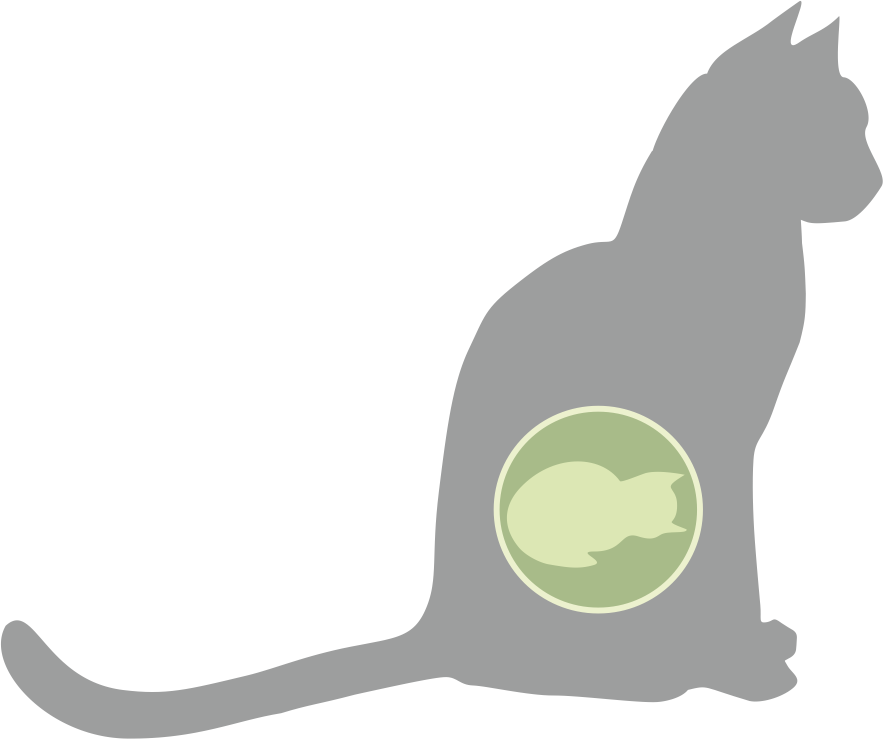
Day 6: Transfer of the fertilised eggs to the uterus
Day 12: Settling in the uterine wall
Day 15: Connection of the embryos with the mother cat’s circulatory system.
Day 21: The embryos can now be seen via an ultrasound scan.
Day 28: The embryos are 3-4 cm in size
Day 38: Nerves, sensory organs and muscles are developed.
Day 50: The babies in the making are ca. 7 cm in size now and the fur is growing
Day 60: “Ready for delivery”
The kittens are preparing for the big day. They are now complete, tiny cats “with all the trimmings” and measure ca. 13 cm shortly before delivery.
How many kittens make a litter?
The number of kittens per litter varies. One – two – or up to five kittens enter the world at once, sometimes even six! This depends on the breed as well as on the mating ritual:
When did the female mate and with how many partners?
If the cat decides to mate again during the first three weeks of the gestation period, further fertilisation is well possible.
For that reason, kittens of the same litter often vary a lot – from different fur and eye colour through to individual stages of development at birth.
How do you recognise pregnant cats?
Is your cat expecting or not?
Directly after the mating, the gestation cannot yet safely be identified. Only after three weeks, the developing offspring can be confirmed by way of palpation.
But be careful and let the vet do the examination. A wrong or harsh grip can hurt the kittens a lot! After three weeks, your cat’s nipples will be swollen, turn pink (“pinking-up”) and protrude more than usual. They are also more exposed because the fur around them thins out a little.
Nipples start “pinking-up”
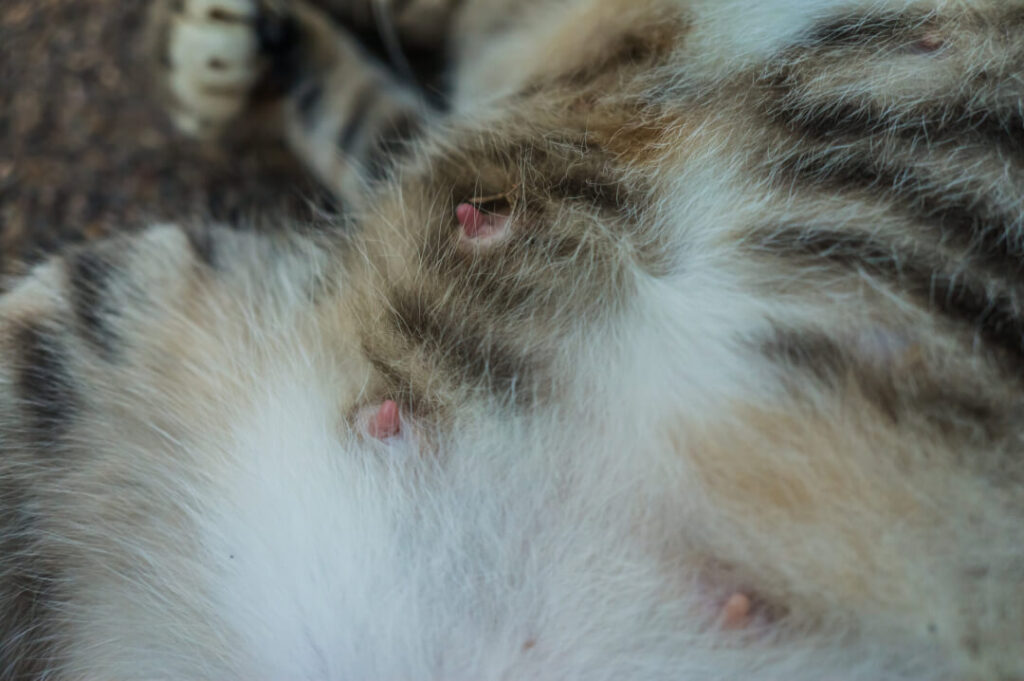
The most obvious sign for your cat’s pregnancy are swollen nipples. They are a sure sign which catches the eye immediately and a safe indicator of growing offspring.
The nipples will not only grow but also change their colour in the following weeks. “Skin-coloured” turns to pink and then to a reddish hue which deepens with time.
Increasing bodyweight and growing belly
When your feline friend is pregnant, her appetite will grow along with the belly! Even if your cat is not constantly ravenous – the tummy will grow and the bodyweight will steadily increase. Depending on the number of embryos, the female can gain up to 2 kilos in weight.
“Mule” figure
Pregnant cats with their constantly changing body often develop a so-called mule look: The bulging belly and developing swayback are indicators for the increasing bodyweight they are carrying around. The growing embryos in their tummy produce a ball shape which in turn causes the spine to bend. The result is a sunken back. This is referred to as “mule figure”.
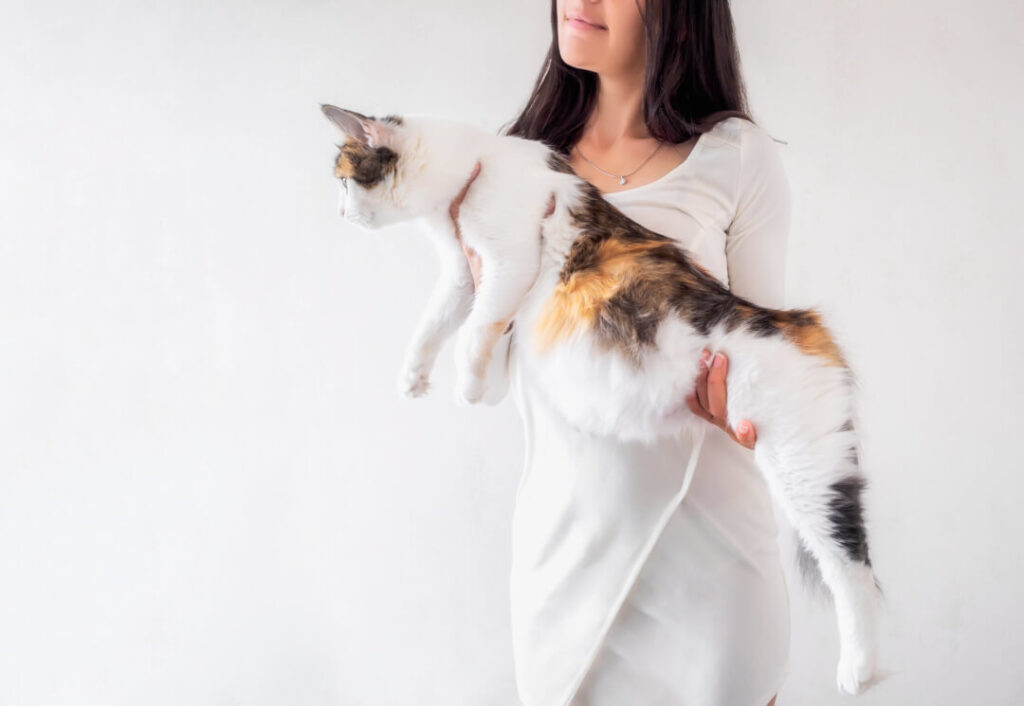
Nesting instinct
Your cat will show typical signs during the gestation period that are often comparative to those indicating human pregnancy, such as frequent sickness and mood swings.
Just a minute ago your cat may have looked for attention and cuddles – in the next it will suddenly retreat and wants to be left alone. For this, the cat will seek out a place where no one has access. Respect her oasis of peace and tranquillity! Adjusting to the physical changes is as challenging for your pregnant cat as for a human mother-to-be.
Consult a vet
Feline pregnancy is never easy to detect in the beginning. If you are seeking early official confirmation, it is best to consult a vet. The doctor is able to tell you through palpation as of the 17th day after mating, if offspring is expected. As of the 21st day, an ultrasound allows for visual confirmation. The number of kittens can finally be estimated around the 40th day. It takes this long because the little ones are cramped like sardines in a tin anbilical cord clampCarton with cotton fleeceHeating padDisposable gloves/ hand sanitationPen and paperSuction catheterMobile or telephone with vet’s number
Pregnant or worms’ belly
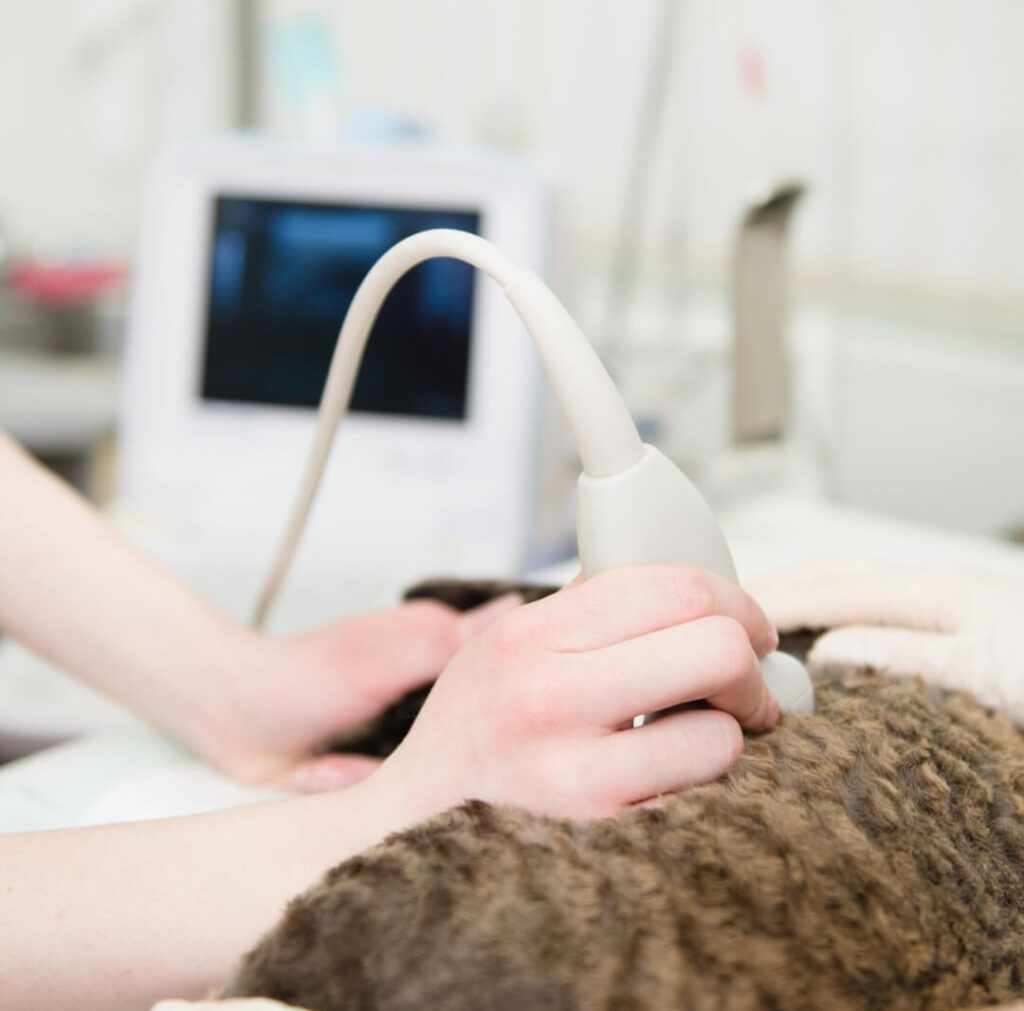
Is your cat pregnant or does it have a “worm belly”?
An increased appetite and a thicker belly do not necessarily indicate offspring.
There can also be a worm infestation, a deficiency, an allergy or a disease. If the condition persists and seems suspicious to you, check whether worms are at work. If a worm infestation occurs, cats also get a big, swollen belly.
If you are unsure, introduce your cat to a vet who will check your cat, find out the exact type of worm and give you the right remedy.
Keep in mind: A visit to the vet’s is never a piece of cake and should only be undertaken in case of real need – but better to be safe than sorry!
What does a pregnant cat need?
Your cat’s body is changing a lot during pregnancy and the needs therefore are different from those of a non-pregnant female.
What should you be aware of? What could potentially be harming for mother and offspring? How can you make the gestation period as pleasant as possible for our animal?
Provide enough light and airfor the mother-to-be.
Exercise in moderation is always a good idea. However, high jumps are to be avoided as well as cat fights, which can not only cause stress but are potentially dangerous for your cat as well.
No need to pamper your cat or treat it like a porcelain doll, but try to avoid stressful and unfamiliar situations.
What food does a pregnant cat prefer?
Pregnant cat – what is the right food?
Nutrition is a major factor during pregnancy as your cat’s body changes massively and needs a lot more energy than usual. For example, an increased daily calories-intake by 50% is recommended.
Make sure that the future mum has access to enough high-quality food and fluids with all the necessary minerals and vitamins needed during pregnancy.
The food required for pregnant and mother cats can be obtained from any specialist shop. If you like to prepare it yourself, please make sure to include all the necessary elements – such as protein and vitamins – that your cat needs now. Best to compose a food plan, so that the nutrition for your pregnant cat is well balanced.
By the way, the future mum should enjoy the same kind of food also during the nursing period, when the little ones still get all of their nutrition from her.
Nesting instinct
During the last phase of the pregnancy, you will be able to observe your cat looking for the perfect spot for giving birth, undisturbed and in peace.
You can help by providing a comfortable birthing box – it should be big enough for the future mum and their kittens to freely move around.
A lidded box, nice and warm but not too hot, placed in a quiet corner free of drafts would be perfect.
Avoid medication and vaccinations
Vaccinations should be done prior to the gestation period, so that antibodies are already present and can be passed on to the kittens via the mother’s milk. The same goes for de-worming: This should also be done before the mating season, so that the little ones don’t get infested through the mother’s milk. De-worming therapies and medications: Ideally, a cat should be de-wormed prior to a pregnancy. If not, this should happen during gestation at the latest, so that the milk is worm free and there is no danger of infestation of the kittens via the mother. Never medicate or treat your cat without consulting the vet – who will be able to advise you on the correct medication suited for pregnant animals.
Allow for cuddling time
As the big day nears, your cat will become more affectionate and clingy. Young cats are often specifically anxious, especially during their first pregnancy.
Don’t leave them alone too much. Spend a lot of time with them and spoil them rotten, even if to them giving birth is a natural process and may be able to do it all by themselves in the end. Yes, they prefer to be alone and without the help of a human “midwife” on their big day, but there is no harm in showing them upfront that we are there for them if needed. We receive so much affection from them – now is the time to give something back.
Cats giving birth
The delivery of the little kittens into this world is a very special event.
The wonder of life – and you are right there when the little ones draw their first independent breath! You can support the mum and kids and be right by their side!
Giving birth is a natural process and your cat will – usually – know exactly what to do.
You can support your cat by preparing the environment, peace and quiet needed for giving birth but during the actual act, your cat will need her concentration and her space.
Only interfere in case of complications.
The birthing will be conducted in three phases. During the opening phase, the contractions begin. Then, the cervix opens. Then, during the expulsion phase, the kittens are born.
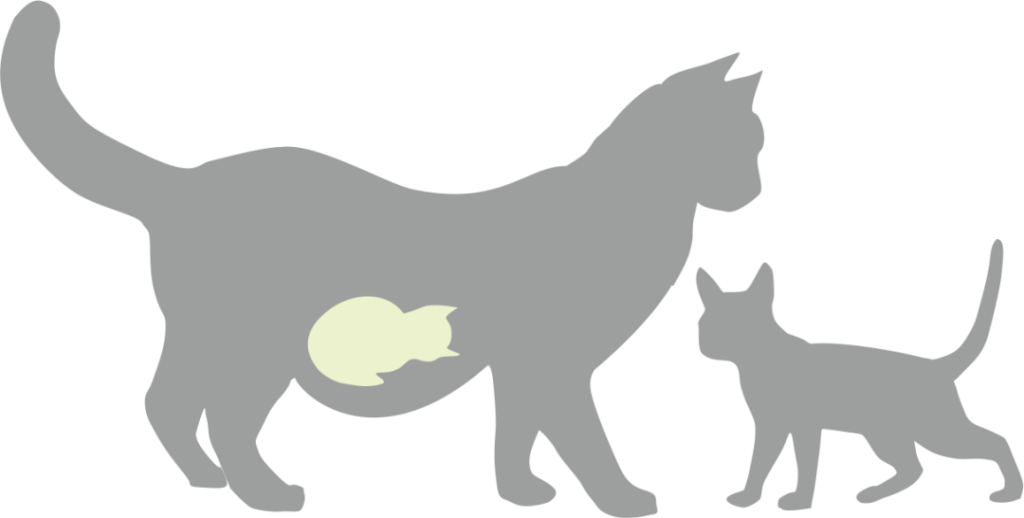
Indications for the beginning of labour
When exactly will it start? What are the signs for your cat entering the birthing phase?
Shortly before start, the kittens have grown quite a bit within their mum’s belly – and may have even been seen moving around! As soon as your cat starts looking for a safe delivery spot, you can be sure that things will start soon.
The mum-to-be walks around and examines everything, from wardrobes to drawers to laundry basket. All the favourite spots will subjected to a thorough inspection.
Enlarged nipples
During the gestation period, the belly has grown more and more. In the end, it sinks down which gives your cat a pear-shaped figure. Shortly before delivery, the nipples are swollen even more. They now look like small funnels, sometimes already leaking drops of mother’s milk. There will be some discharge from the vagina and a mucus plug will be released.
Cat stops eating
One day prior to giving birth, your cat may eat less or will stop eating altogether. However, she will be thirsty and drink a lot more than usual.
Some may be sick, others dig in as usual. Neglecting food will not be the case with all cats and thus is not a certain sign that the start of labour is imminent.
Cat acts fidgety and nervous
Prior the start of labour, many cats will become restless, will look for their birthing spot or go to the litter box repeatedly. They will wander about looking for a place for giving birth, even if this has been chosen already. Some will breathe harder, or their mewing may get loud and piercing. Premature contractions can already announce themselves in this phase – the belly contracts now more often.
Repeated trips to the toilet
No two cats are the same when giving birth and may react differently. Before beginning of labour, some may wash themselves constantly, especially after the vaginal discharge and the release of the mucus plug. Others will go to the litter tray repeatedly, because they feel the pressure of the oncoming labour activity. But at this point they will not be able to release urine or faeces – both can be a sign for the big event starting soon.
Cat hiding
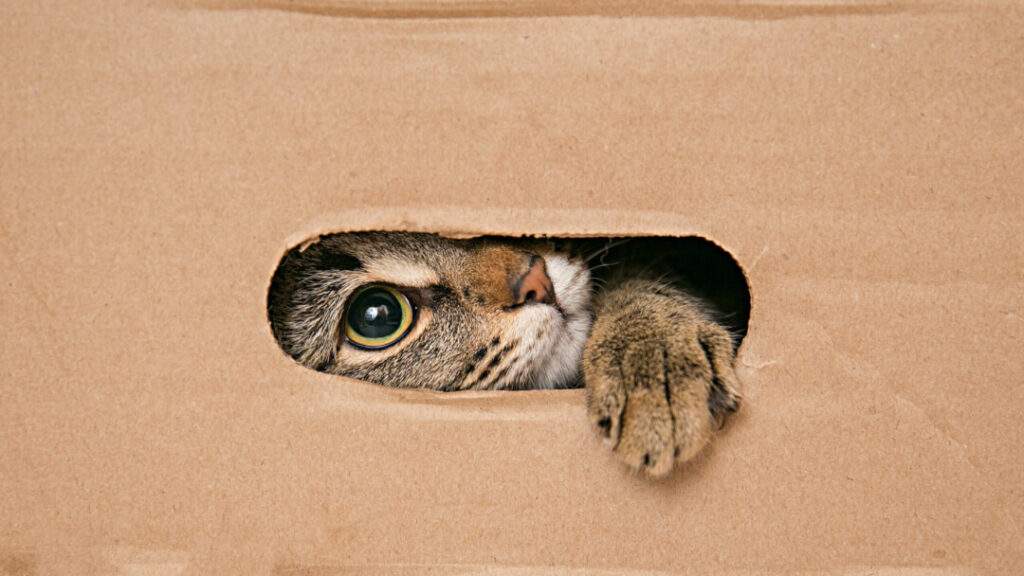
“Do not disturb!”
You will know by the way your cat is acting that she needs to retreat and be alone now. In case of giving birth in nature, she would now look for a secure, secluded place.
After giving birth, a wild cat even changes the nursery often, so that natural enemies can’t track down the little ones by their smell. Shortly prior to giving birth, your cat will therefore retreat to a quiet hiding place within the flat; favourites are wardrobes and drawers, as they provide a safe space where no one can observe them.
Kittens need a special cat toilet, which is smaller and easier to access. It must have a lower rim and an entry aid. Exchange the litter tray after a maximum of two years at the latest. The constant scratching on the surface causes it to crack after a while and the plastic is then not hygienicilet should be filled with non-clumping litter that is well tolerated.
Prepare for your cat giving birth
On realising that labour may start soon, you should make sure that the birthing box is set up in a warm, quiet place. But don’t overdo it – tropical temperatures are not wished for.
A room temperature of 21-22 degrees is ideal. This is important because the kittens depend on a constant room temperature during their first days. Just like human babies, they are not able to keep their own body temperature on a constant level in the beginning.
- Clean towels or sheets
- Sanitised scissors
- Umbilical cord clamp
- Carton with cotton fleece
- Heating pad
- Disposable gloves/ hand sanitation
- Pen and paper
- Suction catheter
- Mobile or telephone with vet’s number
Apart from a cosy birthing place, the following items should be at hand:
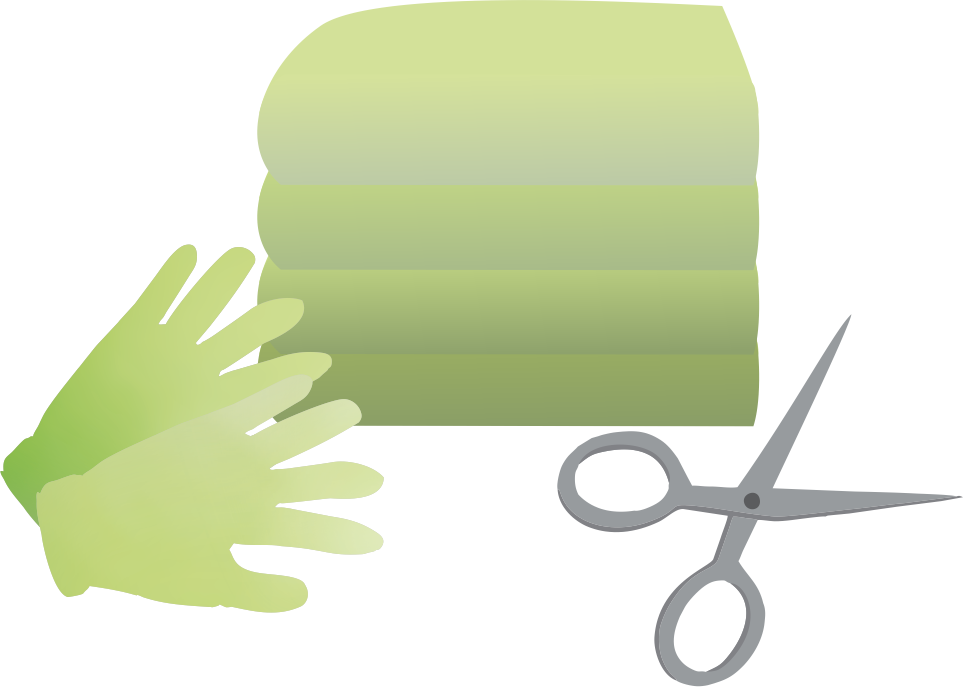
Preparing the birthing box
Prior to the expected delivery date, the birthing box should be ready. Here is an example:
However, those with a knack for crafts are free to design their own.
Post delivery, you should install a heat lamp, so that the little ones will feel warm and cosy at all times.
The entry should be elevated, so that the mum cat can enter and leave at her leisure, but tte for a day – that is no problem as yet.
However, if a baby suddenly doesn’t gain weight for two days or even loses some, you should monitor it more closely and consult the vet.
Sometimes, a kitten is neglected or not looked after by the mother cat, or there is simply not enough milk for all.
Then, you need to jump in and feed the little one every two hours. Do not forget to lightly massage belly and butt after the meal to trigger digestion.
TIP: Start to collect newspapers early on, you will need a lot them!
When the birthing box is safely installed and fitted, the aspiring mother can take some test naps in it. That way, she can get used to the box and make it hers because it smells like her already. Make sure she will find her litter tray, her food and fresh water nearby.
The distances to litter tray and food should be kept short so that the kittens are not left on their own for too long. They will stay warm with the help of the heat lamp, but there is no replacement for the natural warmth of their mother’s body. By the way, it might still happen that your cat chooses another spot for delivery at the last minute – don’t be cross with her if that happens.
As you know, cats follow their own mind – especially when it comes to their offspring!
Keep the scales ready
Keep a protocol of the birthing process. Write down both order and weight of the kittens at delivery. Give them names. Take a picture (camera or smartphone), so that you can match the data more easily later on. In case the kittens all look alike, recording the data can be hard later on, while a variety in appearance makes things a lot easier.
To weigh the tiny new kittens, a digital scale works best.
Clean towels
On delivering the babies, they are covered with a membrane which the mother usually cuts with her teeth, just like the umbilical cord. She will then lick the newborn to make sure it starts breathing. If your feline friend becomes tired or irritable, you can help her: Take a clean towel and gently wrap the little ones dry – thus the membrane will be opened automatically and you will trigger both the breathing and the circulation.
If the mother fails to bite through the umbilical cord, you can also be of help: Clamp the cord at a distance of ca. 1 cm from the belly and use the sanitised scissors to cut it above the clamp. If the towels are soiled with fluids and blood after birthing, exchange them with clean ones so that the “cradle” stays dry, clean and warm.
Snug and warm
The newborns must be snug and warm at all times.
Additional warmth can be generated by heat lamps.
These however should not be flooding the entire box, but only a certain part. Otherwise, it can get too warm and the little ones could loose too much body fluid through the constant radiation.
Heat cushions are also a good idea. They should be wrapped in a towel to protect both cushion and kittens and to avoid giving off too much heat at once.
If the best heating source – the mother – is not around, you can help keeping the kittens warm in various ways. Especially efficient are grain pillows which can be warmed up. Hot water bottles are not ideal as they may fall victim to growing teeth and claws which need to be tested…
Weighing the kittens
Every newborn kitten should be weighed. If you do this regularly, you have the necessary control on their development. Kittens of the same litter can vary in size and weight and develop in different ways.
Not all of them search and find their mum’s nipples at the same speed – there are the “go-getters” that are always first at the source; others may take their time or are more reticent in general.
Temperaments vary, also with kittens! If one does not gain enough weight and or grow sufficiently over the weeks, you should consult your vet. Most newborn kittens weigh between 80 and 120 g. The kittens should grow by 5-10% in weight daily. Within one week, they should have doubled in weight.
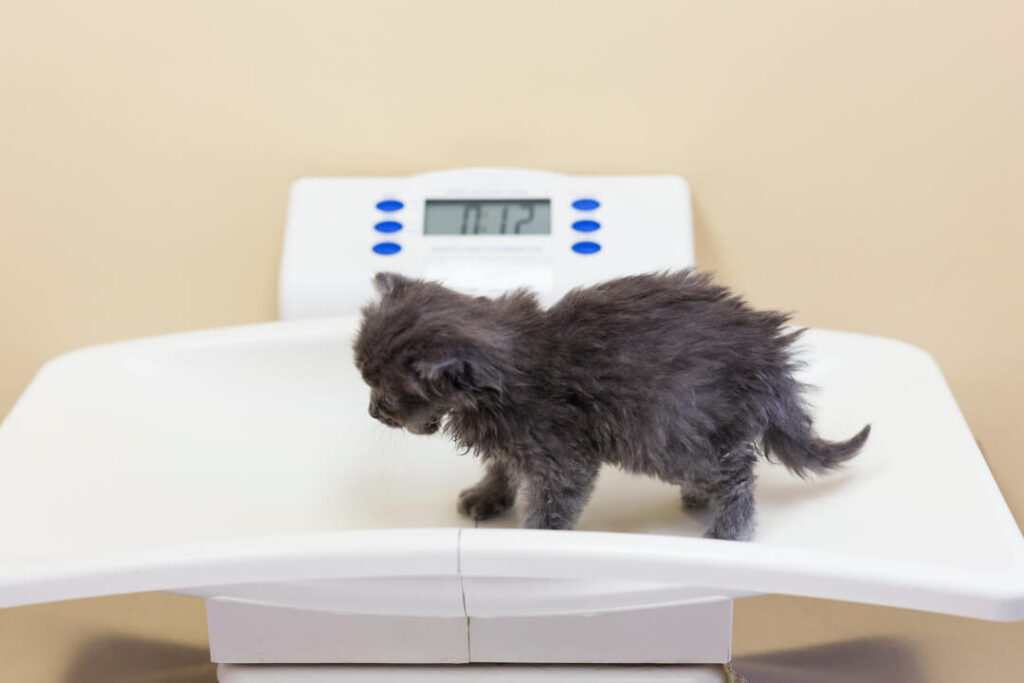
Counting placentas
On delivering the newborn, the cat mum licks its fur dry and eats up the placenta. One placenta per kitten should thus be taken care of by the mother.
Watch for each placenta to appear and be dealt with.
In the case of placentas remaining in the womb, they must be removed by the vet to avoid infection.
Register complications
Sometimes, birthing can get problematic.
Young and inexperienced cats especially can be prone to complications. If the aspiring mother suffers labour for too long and nothing happens, or if the kittens are positioned in a problematic way, things can get dangerous for both mother and offspring. In that case, call the vet, who will be able to help.
Sometimes, there is not enough mother’s milk and the cat is not able to feed her offspring sufficiently.
In this case, you need substitute formula with colostrum – that is what the newborn kittens need in the beginning.
After giving birth
It’s done! The babies are there. Mother and kittens are well, hopefully. A birth is very exhausting, that is why both mom and her children are pretty tired shortly afterwards.
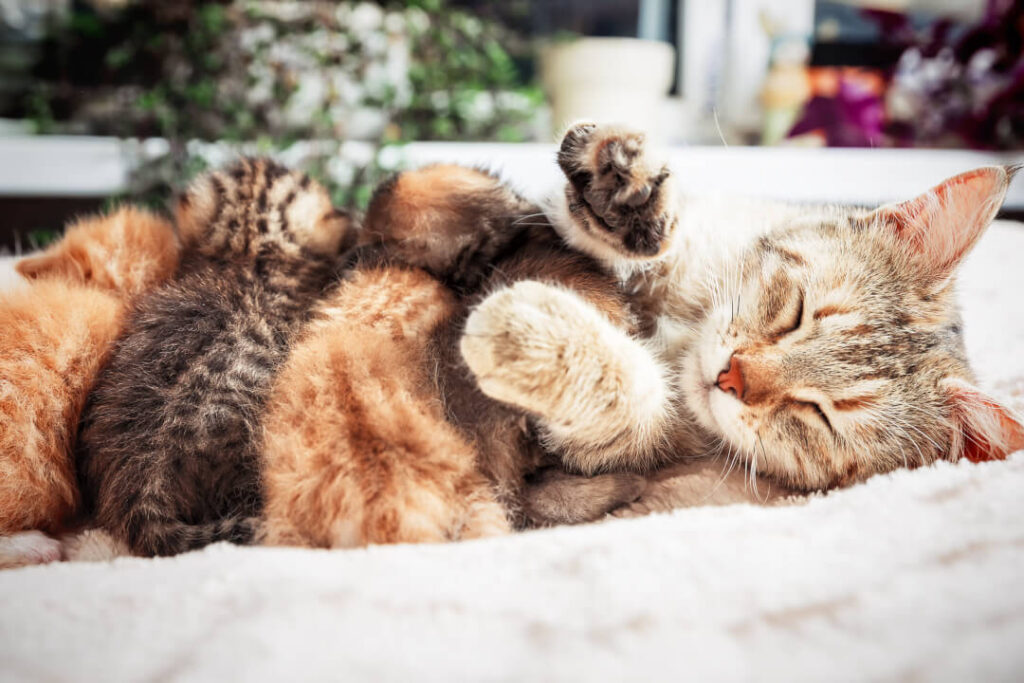
As soon as the kittens are busy with their first meal, the mother starts cleaning herself. The little ones have searched – and hopefully found – the nipples and are happily drinking away. Often, they just fall asleep afterwards, in the same position. Or their mum starts washing them to trigger metabolism and digestion.
The first mother’s milk entails colostrum, which the little ones must not miss out on, because it strengthens their immune system and protects them from infections.
Many mother cats instinctively transfer their kittens to a different place after giving birth, to protect them from predators who could smell both the blood and the newborns from far away. Perfect therefore for the new mother: A second clean and warm nursing box, ready to move in to.
Food and litter tray nearby
At first, the cat mother will not leave the box at all, except for a meal or going to the cat toilet. Place both toilet and food nearby to keep the distances short and allow her to return to her kittens quickly.
The little ones don’t need their own toilet at first because their mother takes care of cleaning them up.
Only by the time that you give them extra food parallel to the mother’s milk, an extra litter tray should be placed in a corner of the nursing box.
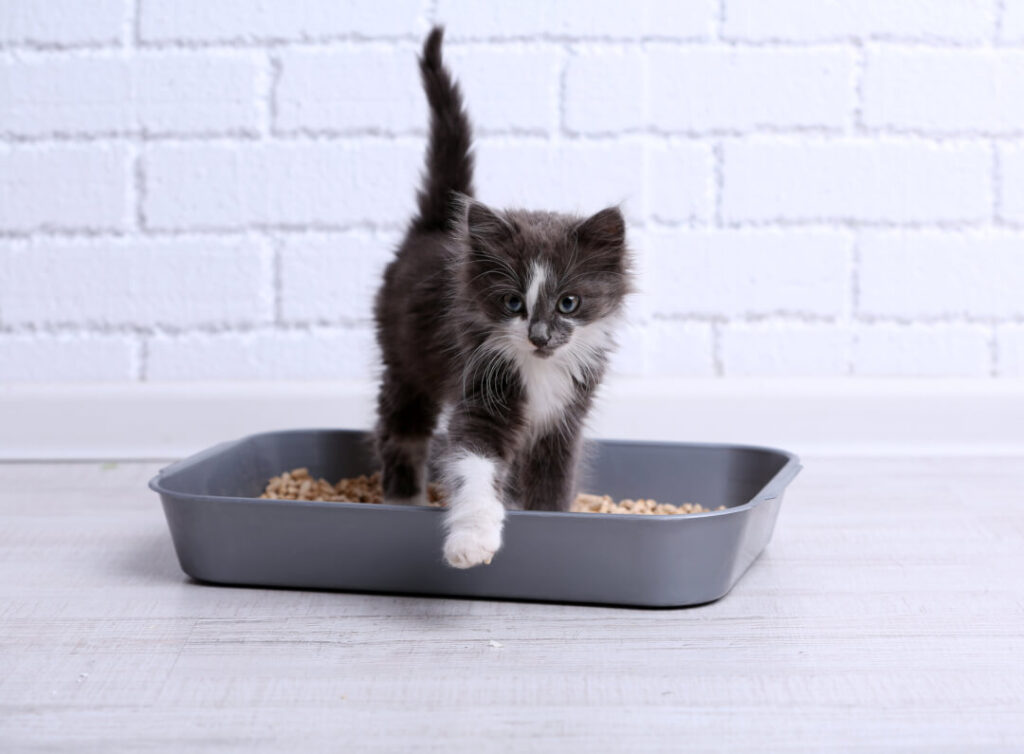
TIP: The ideal cat’s toilet should be made from high-quality, easy-to-clean and recyclable plastic. It must allow for sufficient space because the kittens like moving around. In addition, they like to leave their excretions in various different spots; favourites are wardrobes and drawers, as they provide a safe space where no one can observe them.
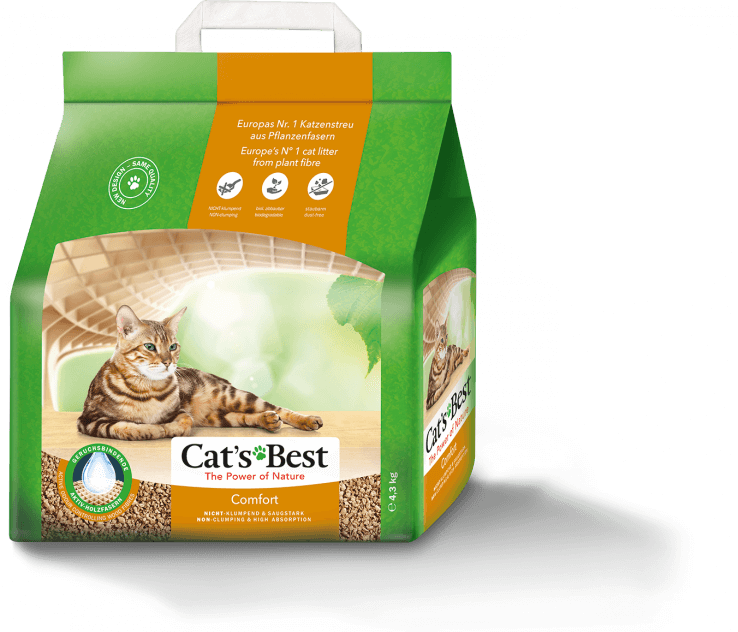
Make sure that you fill the litter box with bedding that does not clump and is well tolerated.
Cat’s Best Comfort is perfect.
Cream and egg yolk for the mother cat
Cats enjoy to eat various small portions throughout the day. This equals their habits in the wild, where they would eat from their freshly caught prey immediately. Provided that they are good hunters, of course. Having food available three times a day is ideal for a grown cat, while kittens need to be fed five times a day.
The mother cat needs high-quality food after giving birth as well.
You may increase the usual amount and add small portions of cream and egg yolk now. Always take very fresh eggs and skip the egg white. Feed your cat the egg yolk only, after having separated it from the egg white.
Give your cat the peace it needs
Your cat will be extremely exhausted after giving birth. The act that the body performs is immense and will leave your cat stressed out. Obviously, labour is no stroll in the park and the whole struggle and pain leaves its traces. Allow for some relaxation and peace for your cat now, so she can recover.
Check the weight of the kittens
You have weighed the little ones right after they were born – that was their “start weight”.
They should have doubled in weight after a week approximately. If you weigh the kittens daily and always at the same time, you can monitor their weight gain sufficiently. Gaining 10 to 20 g per day is normal, while it can also sometimes be less or stagna25 suddenly doesn’t gain weight for two days or even loses some, you should monitor it more closely and consult the vet. Sometimes, a kitten is neglected or not looked after by the mother cat, or there is simply not enough milk for all. Then, you need to jump in and feed the little one every two hours. Do not forget to lightly massage belly and butt after the meal to trigger digestion.
De-worming and vaccinating kittens
De-worming is possible at three weeks of age.
At birth, the kittens are still protected by their mother’s antibodies which they take in with the milk.
However, the protection weakens over time and at 8 weeks, they can be vaccinated for the first time. A second vaccination can be conducted after an additional four weeks. Vaccination means that the organism is confronted with pathogens.
In case of a future infection, these are identified by the immune system as “hostile” and can be fended off. The minimal dosage of pathogens transmitted during vaccination should cause no harm.
Load down the Cat’sBest Vaccination Calendar here. It will support your cat over the whole lifespan and remind you always when it is time for the next vaccination.
Welcome to this world, kitten!
The little rascals will learn how to conquer the world while they are growing up.
The first weeks are the most important ones – when they learn everything a cat needs to know through play and interaction with their mum and siblings and their two-legged friends.
We wish all the kittens a happy, long life, filled with everything that cats love and desire!
